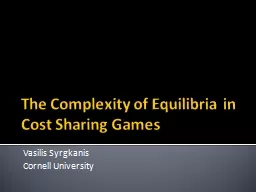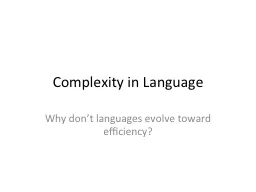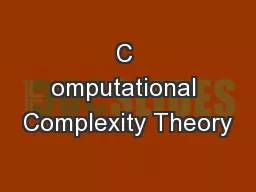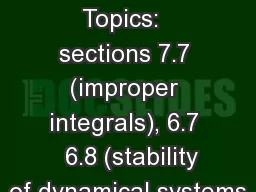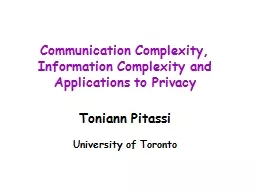PPT-The Complexity of Equilibria
Author : kittie-lecroy | Published Date : 2018-03-08
in Cost Sharing Games Vasilis Syrgkanis Cornell University 4 10 12 10 7 Motivation 10 10 Motivation 5 2 4 5 2 This Work Can we efficiently compute some Pure Nash
Presentation Embed Code
Download Presentation
Download Presentation The PPT/PDF document "The Complexity of Equilibria" is the property of its rightful owner. Permission is granted to download and print the materials on this website for personal, non-commercial use only, and to display it on your personal computer provided you do not modify the materials and that you retain all copyright notices contained in the materials. By downloading content from our website, you accept the terms of this agreement.
The Complexity of Equilibria: Transcript
in Cost Sharing Games Vasilis Syrgkanis Cornell University 4 10 12 10 7 Motivation 10 10 Motivation 5 2 4 5 2 This Work Can we efficiently compute some Pure Nash Equilibrium of such games. Shantanu. . Dutt. ECE Dept.. UIC. Time Complexity. An algorithm time complexity is a function T(n) of problem size n that represents how much time the algorithm will take to complete its task.. Note that there could be more than one problem size parameter n, in which case we can denote the time complexity function as T(S), where S is the set of size parameters. E.g., for the shortest path problem on a graph G, we have 2 size parameters, n the # of vertices and e the # of edges (thus T(S) = T(. Shantanu. . Dutt. ECE Dept.. UIC. Time Complexity. An . algorithm’s . time complexity is a function T(n) of problem size n that represents how much time the algorithm will take to complete its task.. English Language Arts Common Core State Standards. Illinois State Board of Education . English Language Arts Content Specialists. Hosted by Erik Iwersen, June, 2012. . Text Complexity. . “. The Common Core Standards hinge on students encountering appropriately complex texts at each grade level in order to develop the mature language skills and the conceptual knowledge they need for success in school and life. Game Theory. Christos Papadimitriou. Econ/TCS Boot Camp. Before 1995…. A few researchers did both:. v. on Neumann N. Megiddo R. E. Stearns. . Btw: . TCS = . Theoretical Computer Science =. April 26, 2013. Mark Braverman. Princeton University. Based on joint work with Ankit . Garg. , Denis . Pankratov. , and . Omri. Weinstein. Overview: information complexity. Information complexity . :: . Why don’t languages evolve toward efficiency?. “As they evolve, things become more efficient.”. Efficient operations, tools, methods, etc. should drive out those that are difficult and costly.. &. The KY Core Academic Standards for ELA and Literacy in History/Social Studies, Science & Technical Subjects. Included within the . Standards . is an enhanced focus on . text complexity. .. Amanda Jackson. Fronde Systems Group Ltd. Session Code: ARC206. Presentation Outline (hidden slide):. Title: Managing Complexity in a Software plus Services World. Technical Level: All levels. Intended Audience: Developers, Enterprise Architects. Lecture 1: . Intro; Turing machines; . Class P and NP . . . Indian Institute of Science. About the course. Computational complexity attempts . to classify computational . problems. How Understanding Complexity Promotes Simplicity. Why is writing software hard?. ^. great. http://www.infoq.com/presentations/Simple-Made-Easy. Our duty as software architects is to understand and manage complexity. Chapter 7.6. Solubility . Equilibria of . Ionic Compounds. Solubility . is . the quantity of solute that dissolves in a given quantity of solvent at a particular temperature. A . solubility equilibrium . * Read these sections and study solved examples in your textbook!. Work On:. Practice problems from the textbook and assignments from the . coursepack. as assigned on the course web page (under the link “SCHEDULE HOMEWORK”). J. Barkley Rosser, Jr. . Marina V. Rosser. James Madison University. November, 2015. rosserjb@jmu.edu. rossermv@jmu.edu. Abstract. This paper shows which portions of complexity theory are most relevant for studying economic institutional evolution. . Toniann. . Pitassi. University of Toronto. 2-Party Communication Complexity. [Yao]. 2-party communication: . each party has a dataset. . Goal . is to compute a function f(D. A. ,D. B. ). m. 1. m. 2.
Download Document
Here is the link to download the presentation.
"The Complexity of Equilibria"The content belongs to its owner. You may download and print it for personal use, without modification, and keep all copyright notices. By downloading, you agree to these terms.
Related Documents

